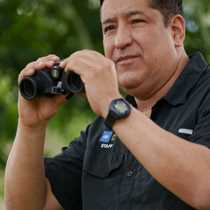Pacaya River & Atun Poza
After travelling the whole night we arrived to the farthest destination we will be in our expedition this week, the Pacaya River. Early in the morning, at around 7:00a.m., we started to travel with our skiffs up the Pacaya River. Our goal was to go as far as we can in the Pacaya.
It was a successful morning in terms of wildlife sightings. We spotted a couple of red howler monkey troops. This monkey species is one of largest monkey species in South America and one of the most famous and attractive, for they have one of the most impressive voices in the neotropical rainforest. The loud howlers’ call sounds just like a mix between a wind storm and an imaginary dragon-like creature. A large troop of squirrel monkeys was seen as well. They were travelling together with a black-fronted capuchin monkey troop. It seems they were hunting insects in tandem. The smaller squirrel monkeys were picking up the smallest insects that the capuchins left while shaking the branches.
We spotted a brown three-toed sloth, hanging from the top of a high tree as well. This sighting was one of the best and most hilarious ones I have ever had with sloths in my life. Please take a look at the attached picture. The quality is not the best but I wanted to share with you the laughter caused by observing an animal hanging upside down, trying to scratch its face a couple of hundred feet above the ground in the most precarious position.
In addition to the many mammal species, we saw several bird species as well. Two species are well worth mentioning. We spotted a large flock of hoatzins as well. This prehistoric-looking bird has a peculiar natural history that has made it famous. It feeds exclusively on leaves and their young have claws in the wings to come back from the water after escaping from predators. A couple of gorgeous blue and yellow macaw flocks were admired as well. Just after the macaws were gone, we spotted several small spectacled caiman alligators as well. The impressive and deep-set eyes of these reptiles caught the attention of their observers.
The icing on the cake was, for many of our guests, the thrill of having our breakfast outdoors onboard the skiffs! This experience is just great! For while being within the rainforest we had our meal served in the most fashionable way, white-gloved crew and fabric napkins in our laps included, with the green surroundings and a concert of tropical sounds as companions. The fun was not over yet, for after breakfast, the skiffs arrived at a large black-water oxbow lake called Yanayacu Lake (“Black Water Lake”). In this remote location, many adventurous swimmers went in the water for a refreshing swim!
After lunch, Delfin II naturalist Jesus Mesia had a presentation on the various human groups that live on this side of the Amazon. He explained about the lifestyles and customs of those who lived in villages that have assimilated the Spanish way of life and Catholicism, and the groups that maintain a more traditional way of life and are hence considered natives, and finally he spoke of the aboriginals who have scarcely even been contacted by the modern world. We truly enjoyed Jesus’ insights and explanations, especially because Jesus comes from one of the indigenous groups of the area, the Boras.
Late in the afternoon we visited “Atun Poza.” In this remote location we had a walk that led to a huge kapok tree (Ceiba pentandra). At the end of the walk we stopped briefly in the town to share some time with the inhabitants, take some photographs and visit a couple of rustic stands to admire and buy some of their handicrafts before coming back to the ship.




